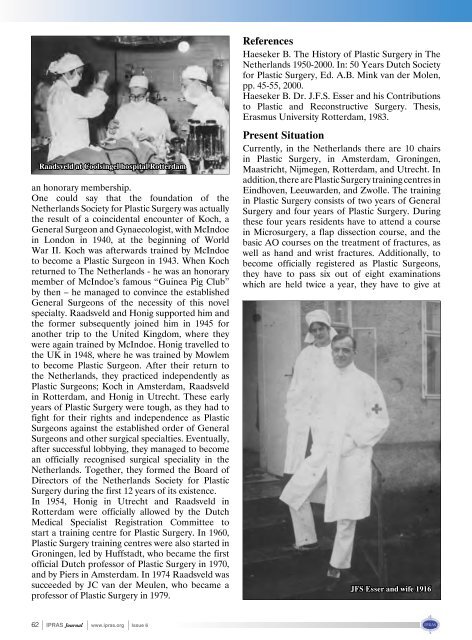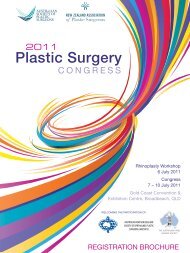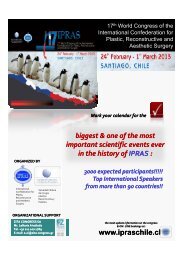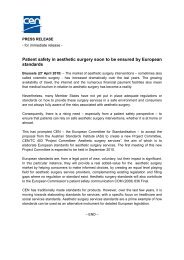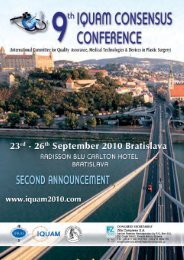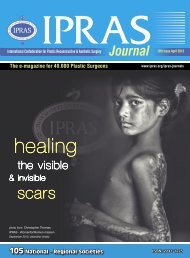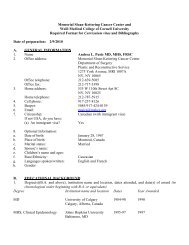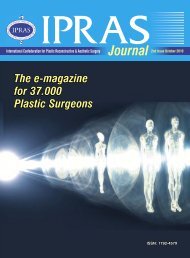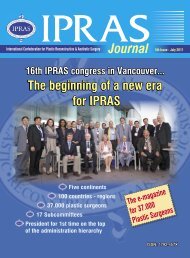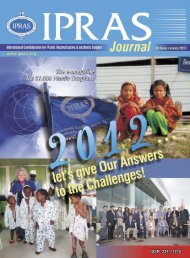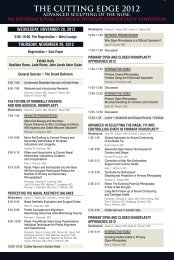Download pdf file - IPRAS
Download pdf file - IPRAS
Download pdf file - IPRAS
- No tags were found...
Create successful ePaper yourself
Turn your PDF publications into a flip-book with our unique Google optimized e-Paper software.
Raadsveld at Coolsingel hospital Rotterdaman honorary membership.One could say that the foundation of theNetherlands Society for Plastic Surgery was actuallythe result of a coincidental encounter of Koch, aGeneral Surgeon and Gynaecologist, with McIndoein London in 1940, at the beginning of WorldWar II. Koch was afterwards trained by McIndoeto become a Plastic Surgeon in 1943. When Kochreturned to The Netherlands - he was an honorarymember of McIndoe’s famous “Guinea Pig Club”by then – he managed to convince the establishedGeneral Surgeons of the necessity of this novelspecialty. Raadsveld and Honig supported him andthe former subsequently joined him in 1945 foranother trip to the United Kingdom, where theywere again trained by McIndoe. Honig travelled tothe UK in 1948, where he was trained by Mowlemto become Plastic Surgeon. After their return tothe Netherlands, they practiced independently asPlastic Surgeons; Koch in Amsterdam, Raadsveldin Rotterdam, and Honig in Utrecht. These earlyyears of Plastic Surgery were tough, as they had tofight for their rights and independence as PlasticSurgeons against the established order of GeneralSurgeons and other surgical specialties. Eventually,after successful lobbying, they managed to becomean officially recognised surgical speciality in theNetherlands. Together, they formed the Board ofDirectors of the Netherlands Society for PlasticSurgery during the first 12 years of its existence.In 1954, Honig in Utrecht and Raadsveld inRotterdam were officially allowed by the DutchMedical Specialist Registration Committee tostart a training centre for Plastic Surgery. In 1960,Plastic Surgery training centres were also started inGroningen, led by Huffstadt, who became the firstofficial Dutch professor of Plastic Surgery in 1970,and by Piers in Amsterdam. In 1974 Raadsveld wassucceeded by JC van der Meulen, who became aprofessor of Plastic Surgery in 1979.ReferencesHaeseker B. The History of Plastic Surgery in TheNetherlands 1950-2000. In: 50 Years Dutch Societyfor Plastic Surgery, Ed. A.B. Mink van der Molen,pp. 45-55, 2000.Haeseker B. Dr. J.F.S. Esser and his Contributionsto Plastic and Reconstructive Surgery. Thesis,Erasmus University Rotterdam, 1983.Present SituationCurrently, in the Netherlands there are 10 chairsin Plastic Surgery, in Amsterdam, Groningen,Maastricht, Nijmegen, Rotterdam, and Utrecht. Inaddition, there are Plastic Surgery training centres inEindhoven, Leeuwarden, and Zwolle. The trainingin Plastic Surgery consists of two years of GeneralSurgery and four years of Plastic Surgery. Duringthese four years residents have to attend a coursein Microsurgery, a flap dissection course, and thebasic AO courses on the treatment of fractures, aswell as hand and wrist fractures. Additionally, tobecome officially registered as Plastic Surgeons,they have to pass six out of eight examinationswhich are held twice a year, they have to give atJFS Esser and wife 191662 <strong>IPRAS</strong> Journal www.ipras.org Issue 6


